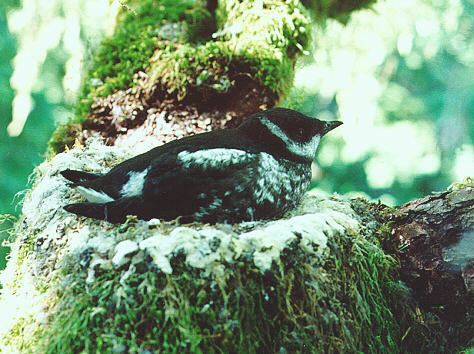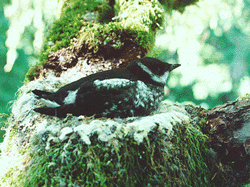From the Open-Publishing Calendar
From the Open-Publishing Newswire
Indybay Feature
Marbled Murrelet
The marbled murrelet is on the U.S. Fish and Wildlife Service Endangered Species List in the southern portion of its range (Washington, Oregon and California). British Columbia lists them as Threatened. California and Oregon list marbled murrelets as critically imperiled. Washington lists them as rare or uncommon.

The marbled murrelet (Brachyramphus marmoratus) is on the U.S. Fish and Wildlife Service Endangered Species List in the southern portion of its range (Washington, Oregon and California). British Columbia lists them as Threatened. California and Oregon list marbled murrelets as critically imperiled. Washington lists them as rare or uncommon.
Murrelets are small, chunky seabirds about the size of a starling. They have webbed feed, sharp black bills, and pointed wings. In summer, their plumage is marbled brown and whitish-gray. In winter they are much more conspicuous with light underparts and dark upper parts. The chicks are covered in a heavy coat of mottled down during their month-long stay in the nest. They pluck or preen off this camoflage one or two days before leaving the nest. Newly-fledged young resemble winter-plumaged adults. Sex cannot be determined in the field.
The marbled murrelet belongs to a group of diving seabirds known as alcids or auks, which inhabit cool, temperate waters of the northern hemisphere, and include such species as puffins, murres, auklets, and guillemoots.
Murrelets may be found in old-aged forests any time of the year, although most birds are found between mid-April and late July. Listen for their shrill "keer keer" calls and muffled wingbeats during the very early morning hours. To observe the birds, gaze up through forest openings and patiently wait for their dark silhouettes to race past. Good indicators of nesting or an occupied stand include birds landing in trees or flying within the forest canopy. Be vigillant for clues on the forest floor such as eggshell ffragments, dropped fish, or chicks that may have tumbled from the nest, or which crash-landed during their maiden flight to the sea. Murrelets often establish flight corridors along valleys or ridge tops.
Source: California State Parks
Murrelets are small, chunky seabirds about the size of a starling. They have webbed feed, sharp black bills, and pointed wings. In summer, their plumage is marbled brown and whitish-gray. In winter they are much more conspicuous with light underparts and dark upper parts. The chicks are covered in a heavy coat of mottled down during their month-long stay in the nest. They pluck or preen off this camoflage one or two days before leaving the nest. Newly-fledged young resemble winter-plumaged adults. Sex cannot be determined in the field.
The marbled murrelet belongs to a group of diving seabirds known as alcids or auks, which inhabit cool, temperate waters of the northern hemisphere, and include such species as puffins, murres, auklets, and guillemoots.
Murrelets may be found in old-aged forests any time of the year, although most birds are found between mid-April and late July. Listen for their shrill "keer keer" calls and muffled wingbeats during the very early morning hours. To observe the birds, gaze up through forest openings and patiently wait for their dark silhouettes to race past. Good indicators of nesting or an occupied stand include birds landing in trees or flying within the forest canopy. Be vigillant for clues on the forest floor such as eggshell ffragments, dropped fish, or chicks that may have tumbled from the nest, or which crash-landed during their maiden flight to the sea. Murrelets often establish flight corridors along valleys or ridge tops.
Source: California State Parks

Add Your Comments
We are 100% volunteer and depend on your participation to sustain our efforts!
Get Involved
If you'd like to help with maintaining or developing the website, contact us.
Publish
Publish your stories and upcoming events on Indybay.
Topics
More
Search Indybay's Archives
Advanced Search
►
▼
IMC Network


